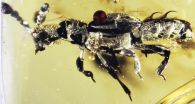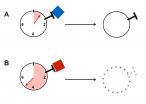(Press-News.org) LA JOLLA, CA—October 2, 2014—Scientists at The Scripps Research Institute (TSRI) have found that an enzyme best known for its fundamental role in building proteins has a second major function: to protect DNA during times of cellular stress.
The finding is remarkable on a basic science level but also points the way to possible therapeutic applications. Strategies that enhance the DNA-protection function of the enzyme, TyrRS, could help protect people from radiation injuries as well as from hereditary defects in DNA repair systems.
"We overexpressed TyrRS in zebrafish and found that they were totally protected from DNA damage induced by ultraviolet radiation," said TSRI Professor Xiang-Lei Yang, who led the research.
The new finding also could lead to a better understanding of the neurodegenerative disorder known as Charcot-Marie-Tooth disease, some cases of which arise from mutations in the TyrRS gene.
The discovery, resulting from a collaboration among several TSRI laboratories, is reported online on October 2 in the journal Molecular Cell.
Many Roles
TyrRS (Tyrosyl tRNA synthetase) belongs to a family of evolutionarily ancient enzymes that are essential for the cellular assembly of proteins. They recognize the codes contained in gene transcripts and link them to the corresponding amino-acids—proteins' building blocks.
TyrRS's job is to recognize the genetic codes that specify the amino-acid tyrosine. But in recent years, TyrRS and other tRNA synthetases, which are relatively abundant in cells, have been found to have additional functions. The first of these reports came in 1999, from the laboratory of TSRI Professor Paul Schimmel, who found that TyrRS sometimes floats out of a dying cell in two pieces, each of which carries an immune-stimulating signal to other cells.
In a study reported in 2012, Yang and her colleagues found that TyrRS appears to have yet another role in the cell nucleus and may relocate there at certain times when protein-making operations slow down.
"Reduced protein synthesis is often linked to a stress response," said Yang, "so we started looking in that direction."
A Team Effort
For the new study, Yang worked with several collaborating laboratories at TSRI. "The breadth of expertise and the collegial environment here make that easy," she said.
The team, including first author Research Associate Na Wei from the Yang lab, started by creating different stress conditions in several cell types. The researchers observed that only "oxidative" stress, a common stress caused by an excess of highly reactive oxygen molecules within cells, sent TyrRS into the nucleus.
What does TyrRS do in the nucleus? To learn more, the team recorded how gene expression patterns changed in cells when TyrRS flooded the nucleus. Many of these changes, they noted, were surges in activity among genes that had previously been linked to DNA protection and repair. Excluding TyrRS from the nucleus prevented those surges.
In subsequent experiments, the team was able to tease apart the molecular details of how TyrRS in the cell nucleus takes the molecular brakes off DNA damage response gene expression. They also were able to show in lab dish experiments that TyrRS's move to the cell nucleus provides considerable protection against oxidative DNA damage—markers of such damage were much lower that way.
"We found that TyrRS promotes the most conservative and error-free homologous recombination pathway for DNA repair, which would help maintain the stability of the cell genome whenever it sustains damage," said collaborating TSRI scientist Associate Professor Xiaohua Wu, DNA repair expert.
To confirm the physiological relevance of TyrRS's protective role, the researchers artificially boosted TyrRS's expression in embryonic zebrafish—effectively forcing some TyrRS into cell nuclei where it could perform its gene-activating role. The TyrRS influx turned out to provide strong protection from DNA damage caused by ultraviolet radiation. (Ionizing radiation is one of many triggers of DNA-damaging oxidative stress, although it can damage DNA directly as well.) Again, when the scientists excluded TyrRS from the zebrafish cell nuclei, the protective effect went away.
"This has been a fruitful Scripps-wide collaboration," said TSRI Assistant Professor Shuji Kishi." In fact, second author, Yi ('Eric') Shi came from the Yang lab at Scripps California, and played a key role by quickly mastering/performing all the essential skills for zebrafish in my lab at Scripps Florida. With the zebrafish model system, we were able to demonstrate TyrRS's genome-protecting role at the level of the organism."
"I was quite surprised to see such a clear result," said Yang.
Potential Medical Applications
In principle, she adds, a therapy that somehow brings more TyrRS into cell nuclei, or mimics its activity there, could provide strong DNA protection for people with radiation or toxin exposure, or hereditary DNA repair defects.
Yang hopes too that TyrRS's newly elucidated role in the nucleus will end up clarifying the mechanisms underlying Charcot-Marie-Tooth (CMT) disease, a collection of hereditary peripheral nerve degeneration syndromes that affect at least a few million people worldwide. Some cases of CMT have been linked to mutations in TyrRS's gene, and a 2009 study found that those mutations don't impair TyrRS's main, enzymatic function in protein translation—which suggests TyrRS's role in the nucleus as the next focus of investigation.
"I suspect that TyrRS's nuclear function is relevant to CMT," said Yang. "That hypothesis has been an important motivation for our work and it's something we intend to pursue further."
INFORMATION:
Other contributors to the paper, "Oxidative stress diverts tRNA synthetase to nucleus for protection against DNA damage," included bioinformatics expert TSRI Associate Professor Andrew I. Su, whose laboratory collaborated in the study, and Yi Shi, Lan N. Truong, Kathleen M. Fisch, Tao Xu, Elisabeth Gardiner, Guangsen Fu, and Yun-Shiuan Olivia Hsu, all of TSRI.
Support for the research was provided in part by the National Institutes of Health (grants NS085092, CA102361, CA140972 and GM080677) and the National Foundation for Cancer Research.
Ancient protein-making enzyme moonlights as DNA protector
The findings from a collaboration of TSRI labs could lead to better therapies for radiation injuries and hereditary disorders such as Charcot-Marie-Tooth disease
2014-10-02
ELSE PRESS RELEASES FROM THIS DATE:
52-million-year-old amber preserves 'ant-loving' beetle
2014-10-02
Scientists have uncovered the fossil of a 52-million-year old beetle that likely was able to live alongside ants—preying on their eggs and usurping resources—within the comfort of their nest. The fossil, encased in a piece of amber from India, is the oldest-known example of this kind of social parasitism, known as "myrmecophily." Published today in the journal Current Biology, the research also shows that the diversification of these stealth beetles, which infiltrate ant nests around the world today, correlates with the ecological rise of modern ants.
"Although ants ...
Counting the seconds for immunological tolerance
2014-10-02
Our immune system must distinguish between self and foreign and in order to fight infections without damaging the body's own cells at the same time. The immune system is loyal to cells in the body, but how this works is not fully understood. Researchers in the Departments of Biomedicine and Nephrology at the University Hospital and the University of Basel have discovered that the immune system uses a molecular biological clock to target intolerant T cells during their maturation process. These recent findings have been reported in the scientific journal Cell.
A functioning ...
DNA 'bias' may keep some diseases in circulation, Penn biologists show
2014-10-02
It's an early lesson in genetics: we get half our DNA from Mom, half from Dad.
But that straightforward explanation does not account for a process that sometimes occurs when cells divide. Called gene conversion, the copy of a gene from Mom can replace the one from Dad, or vice versa, making the two copies identical.
In a new study published in the American Journal of Human Genetics, University of Pennsylvania researchers Joseph Lachance and Sarah A. Tishkoff investigated this process in the context of the evolution of human populations. They found that a bias toward ...
Study indicates possible new way to treat endometrial, colon cancers
2014-10-02
Scientists love acronyms.
In the quest to solve cancer's mysteries, they come in handy when describing tongue-twisting processes and pathways that somehow allow tumors to form and thrive. Two examples are ERK (extracellular-signal-related kinase) and JNK (c-June N-Terminal Kinase), enzymes that may offer unexpected solutions for treating some endometrial and colon cancers.
A study led by Gordon Mills, M.D., Ph.D., professor and chair of Systems Biology at The University of Texas MD Anderson Cancer Center with Lydia Cheung, Ph.D. as the first author, points to cellular ...
Study gauges humor by age
2014-10-02
Television sitcoms in which characters make jokes at someone else's expense are no laughing matter for older adults, according to a University of Akron researcher.
Jennifer Tehan Stanley, an assistant professor of psychology, studied how young, middle-aged and older adults reacted to so-called "aggressive humor"—the kind that is a staple on shows like The Office.
By showing clips from The Office and other sitcoms (Golden Girls, Mr. Bean, Curb Your Enthusiasm) to adults of varying ages, she and colleagues at two other universities found that young and middle-aged adults ...
Strong working memory puts brakes on problematic drug use
2014-10-02
AUDIO:
Atika Khurana, assistant professor in the University of Oregon's Department of Counseling Psychology and Human Services, provides a short summary and the implications of a study that looked at the...
Click here for more information.
EUGENE, Ore. -- Oct. 2, 2014 -- Adolescents with strong working memory are better equipped to escape early drug experimentation without progressing into substance abuse issues, says a University of Oregon researcher.
Most important in the picture ...
Sense of invalidation uniquely risky for troubled teens
2014-10-02
PROVIDENCE, R.I. [Brown University] — Among the negative feelings that can plague a teen's psyche is a perception of "invalidation," or a lack of acceptance. A new study by Brown University and Butler Hospital researchers suggests that independent of other known risk factors, measuring teens' sense of invalidation by family members or peers can help predict whether they will try to harm themselves or even attempt suicide.
In some cases, as with peers, that sense of invalidation could come from being bullied, but it could also be more subtle. In the case of family, for ...
Socioeconomic factors, fashion trends linked to increase in melanoma
2014-10-02
NEW YORK, NY - A century's worth of cultural and historical forces have contributed to the rise in the incidence of melanoma, including changes in fashion and clothing design, according to an intriguing, retrospective research study conducted by investigators in the Ronald O. Perelman Department of Dermatology at NYU Langone Medical Center.
Their findings are the subject of a report, "More Skin, More Sun, More Tan, More Melanoma," in the October 6, 2014 issue of the American Journal of Public Health.
The authors surmised that early diagnosis and improved reporting ...
Herbivores play important role in protecting habitats from invasive species
2014-10-02
Champaign Ill. Herbivores (species that eat plants; e.g. caterpillars) consume more non-native (introduced from other places) oak leaf material in areas with diverse native plant communities than in less diverse communities. Why diverse plant communities tend to resist invasion by non-native plants, remains uncertain. Researchers from the Illinois Natural History Survey and the Morton Arboretum have been examining the potential role of herbivores on the invasion of non-native plant species in diverse plant communities.
The researchers examined herbivore damage on leaves ...
New report urges caution in handling eyewitness identifications
2014-10-02
WASHINGTON -- A new report from the National Research Council recommends best practices that law enforcement agencies and courts should follow to improve the likelihood that eyewitness identifications used in criminal cases will be accurate. Science has provided an increasingly clear picture of the inherent limits in human visual perception and memory that can lead to errors, as well as the ways unintentional cues during law enforcement processes can compromise eyewitness identifications, the report says.
"Human visual perception and memory are changeable, the ability ...
LAST 30 PRESS RELEASES:
Interaction of climate change and human activity and its impact on plant diversity in Qinghai-Tibet plateau
From addressing uncertainty to national strategy: an interpretation of Professor Lim Siong Guan’s views
Clinical trials on AI language model use in digestive healthcare
Scientists improve robotic visual–inertial trajectory localization accuracy using cross-modal interaction and selection techniques
Correlation between cancer cachexia and immune-related adverse events in HCC
Human adipose tissue: a new source for functional organoids
Metro lines double as freight highways during off-peak hours, Beijing study shows
Biomedical functions and applications of nanomaterials in tumor diagnosis and treatment: perspectives from ophthalmic oncology
3D imaging unveils how passivation improves perovskite solar cell performance
Enriching framework Al sites in 8-membered rings of Cu-SSZ-39 zeolite to enhance low-temperature ammonia selective catalytic reduction performance
AI-powered RNA drug development: a new frontier in therapeutics
Decoupling the HOR enhancement on PtRu: Dynamically matching interfacial water to reaction coordinates
Sulfur isn’t poisonous when it synergistically acts with phosphine in olefins hydroformylation
URI researchers uncover molecular mechanisms behind speciation in corals
Chitin based carbon aerogel offers a cleaner way to store thermal energy
Tracing hidden sources of nitrate pollution in rapidly changing rural urban landscapes
Viruses on plastic pollution may quietly accelerate the spread of antibiotic resistance
Three UH Rainbow Babies & Children’s faculty elected to prestigious American Pediatric Society
Tunnel resilience models unveiled to aid post-earthquake recovery
Satellite communication systems: the future of 5G/6G connectivity
Space computing power networks: a new frontier for satellite technologies
Experiments advance potential of protein that makes hydrogen sulfide as a therapeutic target for Alzheimer’s disease
Examining private equity’s role in fertility care
Current Molecular Pharmacology achieves a landmark: real-time CiteScore advances to 7.2
Skeletal muscle epigenetic clocks developed using postmortem tissue from an Asian population
Estimating unemployment rates with social media data
Climate policies can backfire by eroding “green” values, study finds
Too much screen time too soon? A*STAR study links infant screen exposure to brain changes and teen anxiety
Global psychiatry mourns Professor Dan Stein, visionary who transformed mental health science across Africa and beyond
KIST develops eco-friendly palladium recovery technology to safeguard resource security
[Press-News.org] Ancient protein-making enzyme moonlights as DNA protectorThe findings from a collaboration of TSRI labs could lead to better therapies for radiation injuries and hereditary disorders such as Charcot-Marie-Tooth disease




